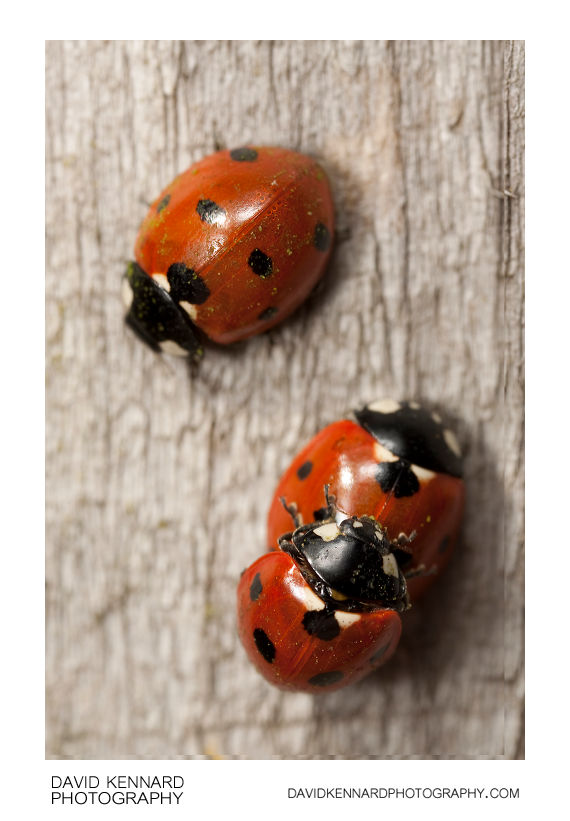Seven spot ladybird Coccinella septempunctata

Description
- Title:
- Seven spot ladybird Coccinella septempunctata
- Caption / Description:
-
Coccinella septempunctata, the seven-spot ladybird (or, in North America, seven-spotted ladybug or "C-7"), is the most common ladybird in Europe. Its elytra are of a red colour, but punctuated with three black spots each, with one further spot being spread over the junction of the two, making a total of seven spots, from which the species derives both its common and scientific names (from the Latin septem = "seven" and punctata = "spotted").
C. septempunctata has a broad ecological range, living almost anywhere there are aphids for it to eat. Both the adults and the larvae are voracious predators of aphids, and because of this, C. septempunctata has been repeatedly introduced to North America as a biological control agent to reduce aphid numbers, and is now established in North America, and has been subsequently designated the official State insect of six different states (Delaware, Massachusetts, New Hampshire, Ohio, Pennsylvania, and Tennessee).
In the United Kingdom, there are fears that the seven-spot ladybird is being out-competed for food by the harlequin ladybird. Conversely, in North America, this species has outcompeted many native species, including other Coccinella.
An adult seven-spot ladybird may reach a body length between 0.76 and 1.0cm (7.6 and 10mm). Their distinctive spots and attractive colors are meant to make them unappealing to predators. The species can secrete a fluid from joints in their legs which gives them a foul taste. A threatened ladybug may both play dead and secrete the unappetizing substance to protect itself.
Description from Wikipedia: http://en.wikipedia.org/wiki/Coccinella_septempunctata
- Tags / Keywords:
-
- Biota
- Life
- Vitae
- Eukaryota
- Animalia
- Animals
- Arthropoda
- Arthropods
- Insecta
- Insects
- Wood
- Coleoptera
- Beetles
- Coccinellidae
- Ladybirds
- Ladybugs
- Lady beetles
- Coccinella
- Coccinella septempunctata
- Seven-spotted ladybird
- Seven-spotted ladybug
- Seven-spotted lady beetle
- Mating
Admin
- Date Original Photo Taken:
- Original File Name:
- _MG_8453-4.psd
- Event:
- Rating:
- Date this image added/last updated on website:
- Original File Dimensions:
- 2848px x 4272px
- File Type:
- JPEG
- Color Mode:
- RGB
- Original Image Color Profile:
- Adobe RGB (1998)
Location
- Location Created:
-
- Sublocation:
- City:
- Market Harborough
- Province/State:
- Leicestershire
- Country:
- United Kingdom
- World Region:
- Europe
- Geo-location:
Rights
- Copyright Status:
- Copyrighted
- Licensing Status:
- Rights Managed
- Available for Editorial Use:
- Yes
- Available for Commercial Use:
- Yes
- Copyright Notice:
- © 2010 Dave Kennard
Camera Data
- Date Digital Resource was created:
- Shutter speed:
- 1⁄200 s
- Aperture:
- f/8
- Camera Model:
- Canon EOS 450D
- ISO:
- 100
- Exposure Compensation:
- 0
- Focal Length:
- 65mm
- Focal Length (35mm equiv.):
- Metering Mode:
- Multi-segment
- Flash:
- On, Fired
- Exposure Mode:
- Manual
- White Balance:
- Manual
- Light Source:
- Exposure Program:
- Manual
Additional shooting metadata
- Lens:
- Canon MP-E 65mm F2.8 1-5x Macro
- Filters used:
- Additional Optics used:
- Setup:
- 2 shots, Handheld
MT24-EX Macro Twin Flash with home-made diffusers
Post Processing
- Image Modified:
- Software used:
-
- Adobe Photoshop CS4
- Adobe Camera RAW
- Post Processing:
Images combined for focus in Photoshop CS4
